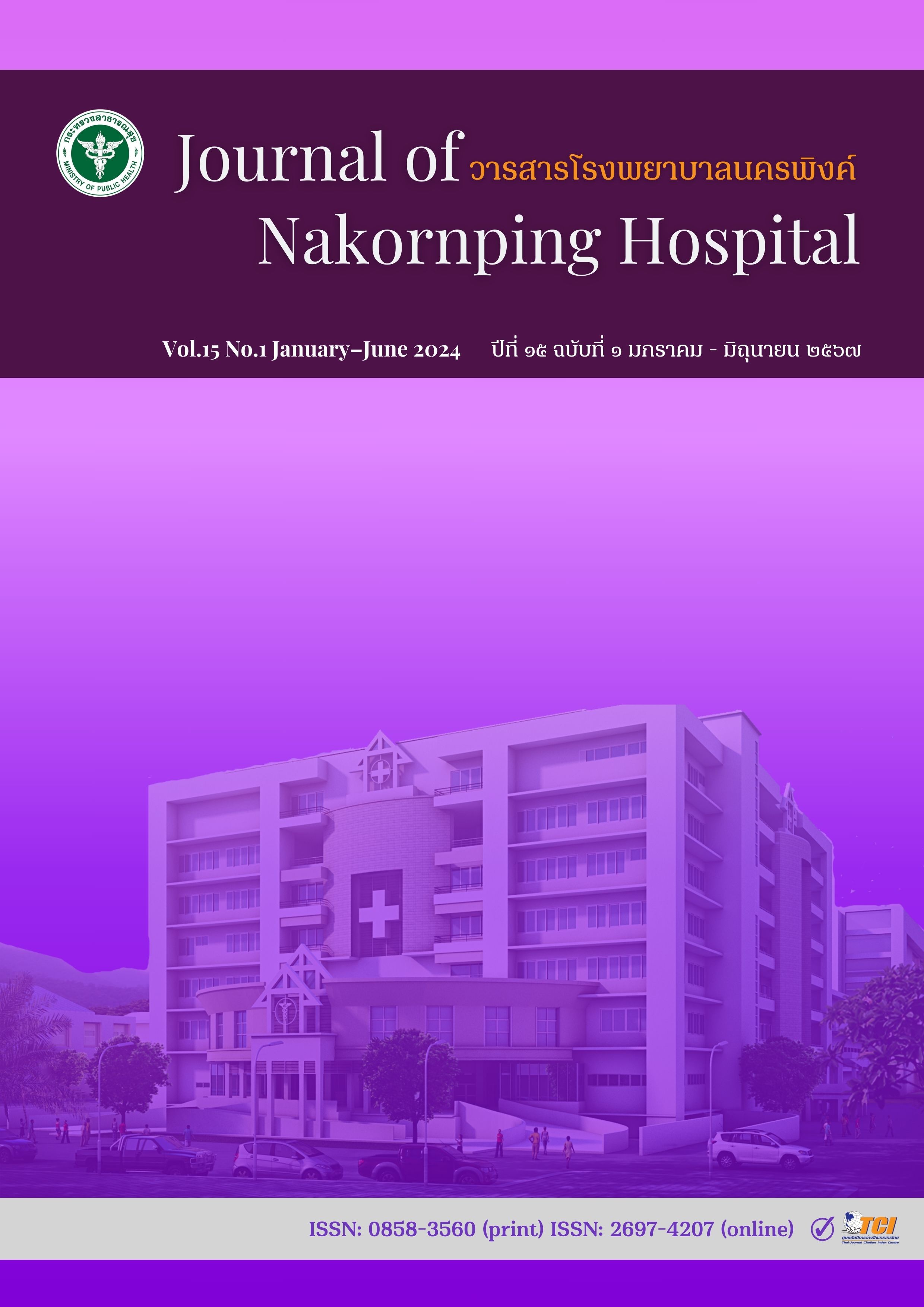ความชุกและปัจจัยที่มีผลต่อภาวะโลหิตจาง ในผู้ป่วยหัวใจล้มเหลวเรื้อรังที่มีการบีบตัวของหัวใจผิดปกติ โรงพยาบาลสมุทรสาคร
คำสำคัญ:
หัวใจล้มเหลวเรื้อรังที่มีการบีบตัวของหัวใจผิดปกติ, ภาวะโลหิตจาง, ภาวะขาดธาตุเหล็ก, New York Heart Association functional classบทคัดย่อ
ที่มา: ภาวะโลหิตจางเป็นโรคร่วมที่สำคัญในภาวะหัวใจล้มเหลวเรื้อรังที่มีการบีบตัวของหัวใจผิดปกติ ซึ่งอาจทำให้ภาวะหัวใจล้มเหลวเรื้อรังแย่ลงได้
วัตถุประสงค์หลัก: เพื่อศึกษาความชุกและปัจจัยสัมพันธ์กับภาวะโลหิตจางของผู้ป่วยหัวใจล้มเหลวเรื้อรังที่มีการบีบตัวของหัวใจผิดปกติระหว่างผู้ป่วยที่มีสมรรถภาพ New York Heart Association (NYHA) ระดับ 1-2 เทียบกับระดับ 3-4
วิธีวิจัย: การศึกษาแบบย้อนหลัง ในโรงพยาบาลสมุทรสาคร ตั้งแต่ 1 กค 2564 – 31 ธค 2565 ศึกษาในผู้ป่วยภาวะหัวใจล้มเหลวเรื้อรังที่มีการบีบตัวของหัวใจผิดปกติ ที่ได้รับการตรวจภาวะโลหิตจาง และมีข้อมูลติดตามภาวะหัวใจล้มเหลวเรื้อรัง วิเคราะห์ปัจจัยระหว่างกลุ่มด้วย multivariable logistic regression นำเสนอด้วย Odds ratio, 95% confidence interval
ผลการศึกษา: ผู้ป่วยหัวใจล้มเหลวเรื้อรังเข้าเกณฑ์การศึกษา 391 ราย มีความชุกภาวะโลหิตจางร้อยละ 52 ทั้งหมดได้รับการตรวจหาภาวะขาดธาตุเหล็กร้อยละ 15 กลุ่มผู้ป่วยหัวใจล้มเหลวเรื้อรังที่มีการบีบตัวของหัวใจผิดปกติตาม NYHA ระดับ 3-4 มีภาวะโลหิตจางเป็นร้อยละ 71.95 มากกว่า กลุ่ม NYHA ระดับ 1-2 ที่มีร้อยละ 46.92 อย่างมีนัยสำคัญทางสถิติ (p < 0.001) พบว่าปัจจัยด้าน NYHA ที่ 3-4 (Adj.OR. 2.32, 95%CI: 1.22-4.43, p = 0.010), เพศหญิง (Adj.OR 2.38, 95%CI: 1.37-4.14, p = 0.002), ดัชนีมวลกายต่ำกว่าปกติ (Adj.OR. 4.71, 95%CI: 1.64-13.57, p = 0.004), โรคร่วมเบาหวาน (Adj.OR. 2.44, 95%CI: 1.42-4.17, p = 0.001) และระดับ serum creatinine (Adj.OR. 2.08, 95%CI: 1.37-3.15, p = 0.006) เป็นปัจจัยที่สัมพันธ์กับการมีภาวะโลหิตจางในผู้ป่วยหัวใจล้มเหลวเรื้อรังที่มีการบีบตัวของหัวใจผิดปกติ ส่วนภาวะความดันโลหิตช่วงล่างสูงสัมพันธ์กับภาวะโลหิตจางในผู้ป่วยหัวใจล้มเหลวเรื้อรังที่มีการบีบตัวของหัวใจผิดปกติ ได้น้อยกว่า (Adj.OR. 0.97, 95%CI: 0.96-0.99, p = 0.006)
สรุป: ในการศึกษานี้ภาวะโลหิตจางในผู้ป่วยหัวใจล้มเหลวเรื้อรังที่มีการบีบตัวของหัวใจผิดปกติมีความชุกสูง โดยเฉพาะกลุ่มที่มีอาการหัวใจล้มเหลวเรื้อรังที่มีการบีบตัวของหัวใจผิดปกติมาก ฉะนั้นการหาสาเหตุและแก้ไขภาวะโลหิตจางจึงมีความสำคัญ
เอกสารอ้างอิง
Tang YD, Katz SD. Anemia in chronic heart failure: prevalence, etiology, clinical correlates, and treatment options. Circulation. 2006;113(20):2454-61. doi: 10.1161/CIRCULATIONAHA.105.583666.
McDonagh TA, Metra M, Adamo M, Gardner RS, Baumbach A, Böhm M, et al. 2021 ESC Guidelines for the diagnosis and treatment of acute and chronic heart failure. Eur Heart J. 2021;42(36):3599-726. doi: 10.1093/eurheartj/ehab368.
Anand IS, Gupta P. Anemia and Iron Deficiency in Heart Failure: Current Concepts and Emerging Therapies. Circulation. 2018;138(1):80-98. doi: 10.1161/CIRCULATIONAHA.118.030099.
Groenveld HF, Januzzi JL, Damman K, van Wijngaarden J, Hillege HL, van Veldhuisen DJ, et al. Anemia and mortality in heart failure patients a systematic review and meta-analysis. J Am Coll Cardiol. 2008;52(10):818-27. doi: 10.1016/j.jacc.2008.04.061.
Anongjanya I, Norasetthada L, Tantiworawit A, Rattarittamrong E, Chai-Adisaksopha C, Rattanathammethee T, et al. Effects of anemia on clinical outcomes among patients with chronic heart failure. J Hematol Transfus Med. 2019;29(1):47-54. [In Thai]
Szachniewicz J, Petruk-Kowalczyk J, Majda J, Kaczmarek A, Reczuch K, Kalra PR, et al. Anaemia is an independent predictor of poor outcome in patients with chronic heart failure. Int J Cardiol. 2003;90(2-3):303-8. doi: 10.1016/s0167-5273(02)00574-0.
Jankowska EA, Rozentryt P, Witkowska A, Nowak J, Hartmann O, Ponikowska B, et al. Iron deficiency: an ominous sign in patients with systolic chronic heart failure. Eur Heart J. 2010;31(15):1872-80. doi: 10.1093/eurheartj/ehq158.
Avni T, Leibovici L, Gafter-Gvili A. Iron supplementation for the treatment of chronic heart failure and iron deficiency: systematic review and meta-analysis. Eur J Heart Fail. 2012;14(4):423-9. doi: 10.1093/eurjhf/hfs017.
Heidenreich PA, Bozkurt B, Aguilar D, Allen LA, Byun JJ, Colvin MM, et al. 2022 AHA/ACC/HFSA Guideline for the Management of Heart Failure: A Report of the American College of Cardiology/American Heart Association Joint Committee on Clinical Practice Guidelines. Circulation. 2022;145(18):e895-1032. doi: 10.1161/CIR.0000000000001063.
Chirakarnjanakorn S, Krittayaphong R, Chantrarat T, Ratanasumawong K, Boonyarattavej SS. Heart Failure Council of Thailand (HFCT) 2019 Heart Failure Guideline: Comorbidity in Heart Failure. J Med Assoc Thai. 2019;102(4):508-12. [In Thai]
WHO Expert Consultation. Appropriate body-mass index for Asian populations and its implications for policy and intervention strategies. Lancet. 2004;363(9403):157-63. doi: 10.1016/S0140-6736(03)15268-3.
Lamb EJ, Levey AS, Stevens PE. The Kidney Disease Improving Global Outcomes (KDIGO) guideline update for chronic kidney disease: evolution not revolution. Clin Chem. 2013;59(3):462-5. doi: 10.1373/clinchem.2012.184259.
Blanc B, Finch CA, Hallberg L. Nutritional anaemias. Report of a WHO scientific group. World Health Organ Tech Rep Ser. 1968;405:1-40.
Okonko DO, Mandal AK, Missouris CG, Poole-Wilson PA. Disordered iron homeostasis in chronic heart failure: prevalence, predictors, and relation to anemia, exercise capacity, and survival. J Am Coll Cardiol. 2011;58(12):1241-51. doi: 10.1016/j.jacc.2011.04.040.
McDonagh T, Damy T, Doehner W, Lam CSP, Sindone A, van der Meer P, et al. Screening, diagnosis and treatment of iron deficiency in chronic heart failure: putting the 2016 European Society of Cardiology heart failure guidelines into clinical practice. Eur J Heart Fail. 2018;20(12):1664-72. doi: 10.1002/ejhf.1305.
Cappellini MD, Comin-Colet J, de Francisco A, Dignass A, Doehner W, Lam CS, et al. Iron deficiency across chronic inflammatory conditions: International expert opinion on definition, diagnosis, and management. Am J Hematol. 2017;92(10):1068-78. doi: 10.1002/ajh.24820.
Abebe TB, Gebreyohannes EA, Bhagavathula AS, Tefera YG, Abegaz TM. Anemia in severe heart failure patients: does it predict prognosis? BMC Cardiovasc Disord. 2017;17(1):248. doi: 10.1186/s12872-017-0680-5.
von Haehling S, Gremmler U, Krumm M, Mibach F, Schön N, Taggeselle J, et al. Prevalence and clinical impact of iron deficiency and anaemia among outpatients with chronic heart failure: The PrEP Registry. Clin Res Cardiol. 2017;106(6):436-43. doi: 10.1007/s00392-016-1073-y.
Oski FA, Marshall BE, Cohen PJ, Sugerman HJ, Miller LD. The role of the left-shifted or right-shifted oxygen-hemoglobin equilibrium curve. Ann Intern Med. 1971;74(1):44-6. doi: 10.7326/0003-4819-74-1-44.
Ezekowitz JA, McAlister FA, Armstrong PW. Anemia is common in heart failure and is associated with poor outcomes: insights from a cohort of 12 065 patients with new-onset heart failure. Circulation. 2003;107(2):223-5. doi: 10.1161/01.cir.0000052622.51963.fc.
Hsu CY, McCulloch CE, Curhan GC. Epidemiology of anemia associated with chronic renal insufficiency among adults in the United States: results from the Third National Health and Nutrition Examination Survey. J Am Soc Nephrol. 2002;13(2):504-10. doi: 10.1681/ASN.V132504.
Qin Y, Melse-Boonstra A, Pan X, Yuan B, Dai Y, Zhao J, et al. Anemia in relation to body mass index and waist circumference among Chinese women. Nutr J. 2013;12:10. doi: 10.1186/1475-2891-12-10.
Evans WJ, Morley JE, Argilés J, Bales C, Baracos V, Guttridge D, et al. Cachexia: a new definition. Clin Nutr. 2008;27(6):793-9. doi: 10.1016/j.clnu.2008.06.013.
Okoshi MP, Capalbo RV, Romeiro FG, Okoshi K. Cardiac Cachexia: Perspectives for Prevention and Treatment. Arq Bras Cardiol. 2017;108(1):74-80. doi: 10.5935/abc.20160142.
Hosseini MS, Rostami Z, Saadat A, Saadatmand SM, Naeimi E. Anemia and microvascular complications in patients with type 2 diabetes mellitus. Nephrourol Mon. 2014;6(4):e19976. doi: 10.5812/numonthly.19976.
Thomas M, Tsalamandris C, MacIsaac R, Jerums G. Anaemia in diabetes: an emerging complication of microvascular disease. Curr Diabetes Rev. 2005;1(1):107-26. doi: 10.2174/1573399052952587.
Tanimura M, Dohi K, Fujimoto N, Moriwaki K, Omori T, Sato Y, et al. Effect of Anemia on Cardiovascular Hemodynamics, Therapeutic Strategy and Clinical Outcomes in Patients With Heart Failure and Hemodynamic Congestion. Circ J. 2017;81(11):1670-7. doi: 10.1253/circj.CJ-17-0171.
ดาวน์โหลด
เผยแพร่แล้ว
รูปแบบการอ้างอิง
ฉบับ
ประเภทบทความ
สัญญาอนุญาต
ลิขสิทธิ์ (c) 2024 โรงพยาบาลนครพิงค์

อนุญาตภายใต้เงื่อนไข Creative Commons Attribution-NonCommercial-NoDerivatives 4.0 International License.
บทความที่ได้รับการตีพิมพ์เป็นลิขสิทธิ์ของโรงพยาบาลนครพิงค์ จ.เชียงใหม่
ข้อความที่ปรากฏในบทความแต่ละเรื่องบทความในวารสารวิชาการและวิจัยเล่มนี้เป็นความคิดเห็นส่วนตัวของผู้เขียนแต่ละท่านไม่เกี่ยวข้องกับโรงพยาบาลนครพิงค์ และบุคลากรท่านอื่นๆในโรงพยาบาลฯ ความรับผิดชอบเกี่ยวกับบทความแต่ละเรื่องผู้เขียนจะรับผิดชอบของตนเองแต่ละท่าน



